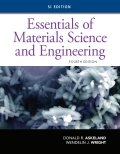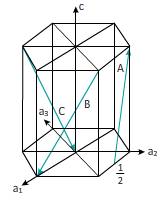
Interpretation:
Miller indices for the directions inthe hexagonal lattice using three- digit and four-digit systems.
Concept introduction:
Miller indices at the planes pass through the three points at edges of the crystal structure. In crystalline material, all the points, planes and directions are specified within the unit cell. The direction is defined as a line between two points.
Answer to Problem 3.57P
Miller indices of hexagonal lattice at given directions.
Explanation of Solution
Given:
The following hexagonal lattice:

Steps for calculating miller indices for given directions are:
- Find head point coordinate (direction of a head point from the origin (x,y,z) )
- Find-tail point coordinate (x,y,z)
- Head point coordinate − tail point coordinate
Miller indices for plane A:
Head points = 0,1,1
Tail point = 1/2, 1, 0
Head point − Tail point:
Four-digit system
Convert the three-digitsystem into a four-digit system.
Coordinates of four-digit system.
Miller indices for plane B:
Head points = 1,0,0
Tail point = 1, 1, 1
Head point − Tail point:
Four-digit system
Convert the three-digitsystem into a four-digit system.
Coordinates of the four-digit system.
Miller indices for plane C:
Three digit system:
Head points = 0,0,0
Tail point = 1, -1, 1
Head point − Tail point:
Four-digit system
Convert three systems into four-digit system.
Miller indices of hexagonal lattice at given directions.
Want to see more full solutions like this?
Chapter 3 Solutions
Essentials of Materials Science and Engineering, SI Edition
- I want to explain my work in Python botnets and it is completely working on the tkinter function with an explanation of how I can work on it with an introduction about what it is and what its benefit isarrow_forward2) The phase voltage at the terminals of a balanced three-phase Y-connected load is 2400 V. The load has an impedance of 16+j12 2/6 and is fed from a line having an impedance of 0.10+j0.80 2/6. The Y- connected source at the sending end of the line has a positive phase sequence and an internal impedance of 0.02+j0.16 2/6. Use the a-phase voltage at the load as the reference. a) Construct the a-phase equivalent circuit of the system b) Calculate the line currents IaA, IbB, and Icc c) Calculate the phase voltages at the terminals of the source, Van, Vbn, Vcn- d) Calculate the line voltages at the source, Vab, Vbc and Vca. e) Calculate the internal phase-to-neutral voltages at the source, Va'n, Vb'n, Ve'n,arrow_forward1) • A balanced three-phase circuit has the following characteristics: Y-Y connected The line voltage at the source is Vab = 120√3(0°V • The phase sequence is positive The line impedance is 2+ j3 2/0 The load impedance is 28 + j37 02/0 a) [4 pts] Draw the single phase equivalent circuit for the a-phase. b) [2 pts] Calculate the line current IaA in the a-phase. c) [4 pts] Calculate the line voltage VAB at the load in the a-phase.arrow_forward
- ||! Sign in MMB241 - Tutorial L9.pd X PDF MMB241 - Tutorial L10.pX DE MMB241 - Tutorial L11.p x PDF Lecture W12 - Work and X File C:/Users/KHULEKANI/Desktop/mmb241/MMB241%20-%20Tutorial%20L11.pdf PDE Lecture W11 - Power and X Draw Alla | Ask Copilot ++ 3 of 3 | D 6. If the 50-kg load A is hoisted by motor M so that the load has a constant velocity of 1.5 m/s, determine the power input to the motor, which operates at an efficiency € = 0.8. 1.5 m/s 2 7. The sports car has a mass of 2.3 Mg, and while it is traveling at 28 m/s the driver causes it to accelerate at 5m/s². If the drag resistance on the car due to the wind is FD= 0.3v²N, where v is the velocity in m/s, determine the power supplied to the engine at this instant. The engine has a running efficiency of P = 0.68. 8. If the jet on the dragster supplies a constant thrust of T-20 kN, determine the power generated by the jet as a function of time. Neglect drag and rolling resistance, and the loss of fuel. The dragster has a mass of 1…arrow_forwardQ | Sign in PDE Lecture W09.pdf PDF MMB241 - Tutorial L9.pdi X PDF MMB241 - Tutorial L10.p X PDF MMB241 - Tutorial L11.p X Lecture W12-Work and X + File C:/Users/KHULEKANI/Desktop/mmb241/Lecture%20W12%20-%20Work%20and%20Energy.pdf ||! Draw | IA | a | Ask Copilot Class Work + 33 of 34 D Question 1 The engine of a 3500-N car is generating a constant power of 50 hp (horsepower) while the car is traveling up the slope with a constant speed. If the engine is operating with an efficiency of € 0.8, determine the speed of the car. Neglect drag and rolling resistance. Use g 9.81 m/s² and 1 hp = 745.7 W. 10 го Question 2 A man pushes on a 60-N crate with a force F. The force is always directed downward at an angle of 30° from the horizontal, as shown in the figure. The magnitude of the force is gradually increased until the crate begins to slide. Determine the crate's initial acceleration once it starts to move. Assume the coefficient of static friction is μ = 0.6, the coefficient of kinetic…arrow_forwardFind the value of V0 using the superposition method. Note: The answer is V0=-428.57mvarrow_forward
- Resolver por superposicionarrow_forwardSteam at atmospheric pressure (Tsat = 100oC, hfg = 2.257×106 J/kg) is in contact with a horizontal tube through which a cooling fluid is circulated. The tube has 0.0334 m outside diameter, 1 m length, and an outside-surface temperature that is maintained at 60oC. Determine the rate of heat that the cooling fluid must remove and the condensation rate. For water at average temperature, ρ L = 974 kg/m3, k = 0.668 W/m·K, ρ v = 0.516 kg/m3, ν L = 0.364×10-6m2/s. g =9.81 m/s2.arrow_forwardSurface A1 of the system shown in the figure below is a graybody with emissivity of 0.56 andsurface A2 is a blackbody.Can you determine view factors F1-2 and F2-1. And draw an analogous electrical circuit based on Ohm’s law and determine the net radiation heat transfer from surface A1 to surface A2 if T1 = 500oC and T2 = 27oC. For the graybody, α = ε. Stefan-Boltzmann constant, σ = 5.676 × 10-8 W/m2·K4.arrow_forward
- An aluminum saucepan has a handle that is fixed to its wall. The handle itself is made of low carbon steel, and will have a plastic grip attached to it that is comfortable to grasp. Before selecting a plastic, it is necessary to have information on the temperature of the carbon steel handle. The carbon steel handle can be considered as a rod 11 mm in diameter and 45 mm long. When being used over a stove burner, the ambient temperature T∞ is 30 oC, and the temperature at the base of the handle reaches T0 = 100 oC. The convective heat transfer coefficient h is 8 W/m2·K and k = 43 W/m·K for low carbon steel. Can you derive the differential equation for the temperature of handle with x as a spatial variable and determine the temperature of handle at the position of 40 mm from the base. Using the general solution attached. Also Can you determine the total heat transfer rate (q) from the handle using the above temperature profile equation and determine the total heat transfer rate (q) from…arrow_forwardFor forced convection, the important variables, their symbols, and dimensional representations are listed below. From the Buckingham method of grouping the variables, the rank of the dimensional matrix is 4. What is the number of independent dimensionless groups in this case? By utilizing the dimensional- analysis approach, find a dimensionless group. (Show just one dimensionless group you can find)arrow_forwardA parallel flow heat exchanger with surface area of 62.5 m2 is to be designed for cooling oil at 80oC with specific heat of 2.5 kJ/kg·oC and mass flow rate of 5.0 kg/s. Water at 15oC flowing at 9.94 kg/s is used as the cooling fluid (cp = 4.19 kJ/kg·oC). 1 W = 1 J/s Can you determine the heat transfer rate and outlet temperatures, assuming an overall heat transfer coefficient equal to 300 W/m2·oC. For heat transfer rate, use the effectiveness, ε, and Check the results with log-mean temperature difference approach. (Calculate the heat transfer rate and compare the value in (1))varrow_forward
 MATLAB: An Introduction with ApplicationsEngineeringISBN:9781119256830Author:Amos GilatPublisher:John Wiley & Sons Inc
MATLAB: An Introduction with ApplicationsEngineeringISBN:9781119256830Author:Amos GilatPublisher:John Wiley & Sons Inc Essentials Of Materials Science And EngineeringEngineeringISBN:9781337385497Author:WRIGHT, Wendelin J.Publisher:Cengage,
Essentials Of Materials Science And EngineeringEngineeringISBN:9781337385497Author:WRIGHT, Wendelin J.Publisher:Cengage, Industrial Motor ControlEngineeringISBN:9781133691808Author:Stephen HermanPublisher:Cengage Learning
Industrial Motor ControlEngineeringISBN:9781133691808Author:Stephen HermanPublisher:Cengage Learning Basics Of Engineering EconomyEngineeringISBN:9780073376356Author:Leland Blank, Anthony TarquinPublisher:MCGRAW-HILL HIGHER EDUCATION
Basics Of Engineering EconomyEngineeringISBN:9780073376356Author:Leland Blank, Anthony TarquinPublisher:MCGRAW-HILL HIGHER EDUCATION Structural Steel Design (6th Edition)EngineeringISBN:9780134589657Author:Jack C. McCormac, Stephen F. CsernakPublisher:PEARSON
Structural Steel Design (6th Edition)EngineeringISBN:9780134589657Author:Jack C. McCormac, Stephen F. CsernakPublisher:PEARSON Fundamentals of Materials Science and Engineering...EngineeringISBN:9781119175483Author:William D. Callister Jr., David G. RethwischPublisher:WILEY
Fundamentals of Materials Science and Engineering...EngineeringISBN:9781119175483Author:William D. Callister Jr., David G. RethwischPublisher:WILEY





